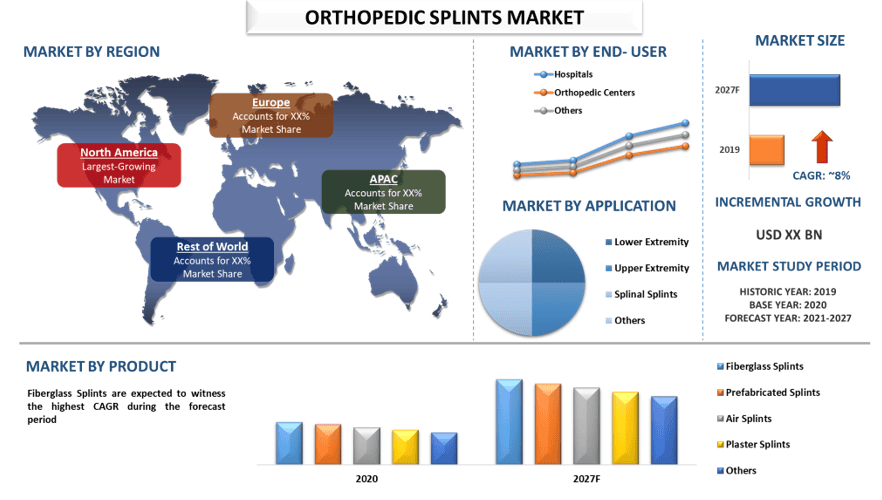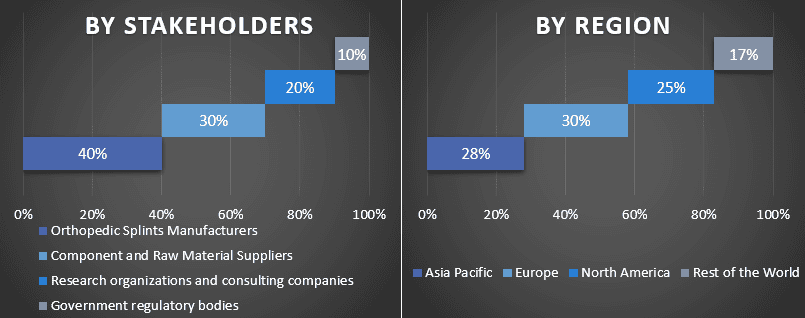整形外科用スプリント市場:現状分析と予測(2021年~2027年)
製品タイプ別の強調(グラスファイバースプリント、既製スプリント、エアスプリント、ギプススプリント、その他)、用途(下肢スプリント、上肢スプリント、その他)、エンドユーザー(病院、整形外科センター、その他)、地域/国

整形外科用スプリントの市場は、2021年から2027年の期間に約8%のCAGRで大きく成長すると予想されています。整形外科用スプリントは、負傷した手足を固定および保護し、治癒を助け、痛みを和らげる補助装置です。負傷した手足をサポートするための緊急措置としても、永続的なケアとしても使用されます。これらのデバイスは、筋肉と骨をサポートして、腫れと痛みを軽減します。スプリントは、非円周状デバイスと見なされます。スプリントは、特定の骨折、軟部組織捻挫、腱損傷、または整形外科的治療を待っている負傷に使用できます。整形外科用スプリントの採用が増加しているのは、骨関連疾患のさまざまな症例の有病率の上昇と、高齢者人口の急速な増加が組み合わされたためです。国連によると、60歳以上の世界の人口は2017年には9億6200万人に達し、2050年までに約21億人に達すると予想されています。たとえば、CDCによると、2017〜2018年には、大腿骨頸部または腰椎、またはその両方における50歳以上の成人の骨粗鬆症の年齢調整有病率は12.6%であり、男性(4.4%)と比較して女性(19.6%)の方が高かった。したがって、世界的に整形外科用スプリント市場を押し上げています。さらに、整形外科用スプリント市場は、関節炎の有病率の増加、この分野で進行中の多数の研究活動、および交通事故や筋骨格系の状態の増加により成長すると予想されています。ただし、骨折数の減少や整形外科用スプリントの高コストなど、市場の制約要因の中には、世界中でこの市場の成長を妨げているものもあります。
Essity AB、3M Company、Ottobock SE & Co. KGaA、DeRoyal Industries Inc.、Medi GmbH & Co. KG、Zimmer Biomet Holdings Inc.、Stryker Corporation、Orthosys、United Medicare、およびSAM Medical Productsは、市場の主要なプレーヤーの一部です。ハイテクで革新的な製品/技術で顧客を支援するために、これらのプレーヤーによっていくつかのM&Aがパートナーシップとともに実施されてきました。
レポートで提示される洞察
「製品の中で、グラスファイバースプリントカテゴリーが2020年に市場の大部分を占めました」
製品に基づいて、整形外科用スプリント市場は、グラスファイバースプリント、既製スプリント、エアスプリント、プラスタースプリント、およびその他に分割されます。グラスファイバースプリントセグメントは2020年に大きな市場シェアを占めており、予測期間中に急速に成長すると推定されています。グラスファイバースプリントの需要は増加し、使いやすさや耐久性などの多くの利点によって促進されると予想されます。これらのスプリントは、軽量であるため、石膏製のスプリントよりもますます好まれています。それらの多孔性により、空気の出入りが容易になります。さらに、グラスファイバースプリントは、負傷した手足を保護および休息させるのに適していると考えられています。
「アプリケーションの中で、下肢スプリントは予測期間中に最高のCAGRを示すと予想されます」
アプリケーションに基づいて、整形外科用スプリント市場は、下肢スプリント、上肢スプリント、脊椎スプリント、およびその他に分割されます。脊椎スプリントセグメントは2020年に大きな市場シェアを占めており、予測期間中に急速に成長すると推定されています。高齢者人口の増加とスポーツ傷害の発生率の増加は、このセグメントの市場成長に寄与する最も一般的な要因です。さらに、交通事故の増加と脊椎関連疾患の有病率の増加が市場を押し上げました。さらに、技術の進歩と新技術および製品の導入が、このセグメントの成長を促進しています。
「エンドユーザーの中で、病院は予測期間中に最高のCAGRを示すと予想されます」
エンドユーザーに基づいて、市場は病院、整形外科センター、およびその他に細分化されています。2020年には、病院セグメントがかなりの市場シェアを獲得しており、複雑な症例の視覚化を改善し、医療効率を向上させ、時間と医療費を削減し、データ管理を改善し、その他多くの利点を提供するために整形外科医に高度なツールを提供するため、予測期間中に大幅なCAGRで成長すると予想されます。これに加えて、国全体の医療施設の数の増加と、病院による研究開発への投資の急増が、整形外科用スプリント市場の成長につながっています。
「北米は予測期間中に大幅な成長を示すでしょう」
整形外科用スプリント市場の市場力学をよりよく理解するために、北米(米国、カナダ、および北米の残りの地域)、ヨーロッパ(ドイツ、フランス、スペイン、英国、イタリア、およびヨーロッパの残りの地域)、アジア太平洋(中国、インド、オーストラリア、日本、およびAPACの残りの地域)を含む世界中のさまざまな地域で詳細な分析が行われています。世界の残りの地域で行われています。北米は、強力な医療インフラストラクチャと地域での整形外科用スプリントの採用の増加により、2020年に整形外科用スプリント市場産業の主要な市場を構成しています。
このレポートを購入する理由:
- この調査には、認証された主要な業界専門家によって検証された市場規模と予測分析が含まれています。
- このレポートは、業界全体のパフォーマンスの簡単なレビューを一目で示しています。
- このレポートは、主要なビジネス財務、製品ポートフォリオ、拡張戦略、および最近の開発に重点を置いて、著名な業界ピアの詳細な分析を網羅しています。
- 業界で普及している推進要因、制約、主要なトレンド、および機会の詳細な調査。
- この調査は、さまざまなセグメントにわたる市場を包括的に網羅しています。
- 業界の地域レベルの分析を深く掘り下げます。
カスタマイズオプション:
グローバルな整形外科用スプリント市場は、要件またはその他の市場セグメントに応じてさらにカスタマイズできます。これに加えて、UMIは、お客様独自のビジネスニーズがある可能性があることを理解しているため、お客様の要件に完全に適合するレポートを入手するために、お気軽にお問い合わせください。
目次
グローバル整形外科用スプリント市場分析(2021年~2027年)における調査方法
グローバル整形外科用スプリント市場の過去の市場の分析、現在の市場の推定、将来の市場の予測は、主要地域における整形外科用スプリントの採用状況を作成し分析するために行われた3つの主要なステップでした。過去の市場数値を収集し、現在の市場規模を推定するために、徹底的な二次調査を実施しました。次に、これらの洞察を検証するために、多数の調査結果と仮定を考慮しました。さらに、グローバル整形外科用スプリント市場のバリューチェーン全体の業界専門家との徹底的な主要インタビューも実施しました。主要なインタビューを通じて市場数の仮定と検証を行った後、完全な市場規模を予測するためにトップダウン/ボトムアップアプローチを採用しました。その後、業界に関連するセグメントおよびサブセグメントの市場規模を推定および分析するために、市場の内訳およびデータ三角測量法を採用しました。詳細な方法論を以下に説明します。
過去の市場規模の分析
ステップ1:二次ソースの詳細な調査:
年次報告書と財務諸表、業績プレゼンテーション、プレスリリースなどの企業内部の情報源、およびジャーナル、ニュースと記事、政府刊行物、競合他社の刊行物、セクターレポート、サードパーティのデータベース、その他の信頼できる刊行物などの外部の情報源を通じて、整形外科用スプリント市場の過去の市場規模を取得するために、詳細な二次調査を実施しました。
ステップ2:市場セグメンテーション:
整形外科用スプリント市場の過去の市場規模を取得した後、主要地域におけるさまざまなセグメントおよびサブセグメントの過去の市場の洞察とシェアを収集するために、詳細な二次分析を実施しました。レポートに含まれる主なセグメントは、製品タイプ、アプリケーション、およびエンドユーザーです。さらに、その地域におけるテストモデルの全体的な採用を評価するために、国レベルの分析を実施しました。
ステップ3:要因分析:
さまざまなセグメントとサブセグメントの過去の市場規模を取得した後、整形外科用スプリント市場の現在の市場規模を推定するために、詳細な要因分析を実施しました。さらに、整形外科用スプリントのさまざまな製品タイプ、アプリケーション、およびエンドユーザーなどの従属変数と独立変数を使用して、要因分析を実施しました。世界の整形外科用スプリント市場セクターにおけるトップパートナーシップ、合併と買収、事業拡大、および製品発売を考慮して、需要と供給側のシナリオについて徹底的な分析を実施しました。
現在の市場規模の推定と予測
現在の市場規模の算定:上記の3つのステップからの実行可能な洞察に基づいて、グローバル整形外科用スプリント市場の現在の市場規模、主要なプレーヤー、およびセグメントの市場シェアに到達しました。必要なすべてのパーセンテージシェア分割と市場の内訳は、上記の二次的アプローチを使用して決定され、主要なインタビューを通じて検証されました。
推定と予測:市場の推定と予測のために、利害関係者が利用できる推進要因とトレンド、制約、および機会を含むさまざまな要因に重みが割り当てられました。これらの要因を分析した後、関連する予測手法、つまりトップダウン/ボトムアップアプローチを適用して、世界中の主要市場におけるさまざまなセグメントおよびサブセグメントについて、2027年頃の市場予測に到達しました。市場規模の推定に採用された調査方法論には以下が含まれます。
- 収益(USD)の観点から見た業界の市場規模と、国内の主要市場における整形外科用スプリント市場の採用率
- 市場セグメントおよびサブセグメントのすべてのパーセンテージシェア、分割、および内訳
- 提供されるソリューションの観点から見た、グローバル整形外科用スプリント市場の主要なプレーヤー。また、これらのプレーヤーが急速に成長する市場で競争するために採用している成長戦略
市場規模とシェアの検証
一次調査:主要な地域全体で、トップレベルのエグゼクティブ(CXO / VP、営業責任者、マーケティング責任者、運用責任者、地域責任者、カントリーヘッドなど)を含む主要なオピニオンリーダー(KOL)との詳細なインタビューを実施しました。次に、一次調査の結果を要約し、述べられた仮説を証明するために統計分析を実行しました。一次調査からの入力は二次調査の結果と統合され、それによって情報を実行可能な洞察に変えました。
さまざまな地域における一次参加者の分割

市場エンジニアリング
グローバル整形外科用スプリント市場の各セグメントおよびサブセグメントの正確な統計数値に到達し、全体的な市場推定を完了するために、データ三角測量法を採用しました。グローバル整形外科用スプリント市場における製品タイプ、アプリケーション、およびエンドユーザーの分野におけるさまざまなパラメーターとトレンドを調査した後、データをいくつかのセグメントとサブセグメントに分割しました。
グローバル整形外科用スプリント市場調査の主な目的
グローバル整形外科用スプリント市場の現在および将来の市場動向は、調査で正確に指摘されました。投資家は、調査で実施された定性的および定量的分析から、投資の裁量に基づいた戦略的洞察を得ることができます。現在および将来の市場動向は、地域レベルで市場の全体的な魅力を決定し、産業参加者が未開発の市場を活用して、先行者利益として利益を得るためのプラットフォームを提供しました。調査のその他の定量的な目標は次のとおりです。
- 金額(USD)の観点から見た、整形外科用スプリント市場の現在および予測市場規模を分析します。また、さまざまなセグメントおよびサブセグメントの現在および予測市場規模を分析します。
- 調査のセグメントには、製品タイプ、アプリケーション、およびエンドユーザーの分野が含まれます。
- 整形外科用スプリント市場業界の規制枠組みの定義と分析。
- 業界の顧客と競合他社の行動を分析するとともに、さまざまな仲介業者の存在を伴うバリューチェーンを分析します。
- 主要地域における整形外科用スプリント市場の現在および予測市場規模を分析します。
- レポートで調査された地域の主要国には、アジア太平洋、ヨーロッパ、北米、および世界のその他の地域が含まれます。
- 整形外科用スプリント市場の企業プロファイルと、市場プレーヤーが急速に成長する市場で維持するために採用した成長戦略
- 業界の詳細な地域レベルの分析
関連 レポート
この商品を購入したお客様はこれも購入しました










